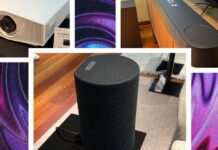Uber has always been about the network, spending much of the past decade weaving webs of drivers, passengers, restaurants, bikes, scooters, and (someday) flying cars. Now, it’s launching a digital lattice of a different kind. This April, starting in Atlanta, Uber will introduce what it calls a “new omni-present advertising network that cuts through clutter with street-level engagement.” In other words, it plans to blast ads at passers-by with digital screens atop its drivers’ cars.
With the move—dubbed Uber OOH, for out-of-home, the term for advertising that includes billboards and the like—the company is jumping into a market pioneered by a handful of startups. The largest of these, Firefly, has installed digital screens on thousands of cars in San Francisco, Los Angeles, New York, Chicago, Miami, and Dallas. Lyft, too, may be moving into the space: It recently acquired Halo Cars, a small Philadelphia-based startup that offers car-topping ad screens, Axios reported last week.
Uber’s ad program will begin in April in Atlanta, Dallas, and Phoenix. It will start with 1,000 cars and pay drivers $300 to install the screen, which is about four feet long and sits atop a roof rack. Drivers will get $100 for each week they drive more than 20 hours to start, before the model shifts to paying them by the hour, according to Adweek. That’s a bit sweeter than Firefly’s offer of about $300 a month, restricted to drivers who spend at least 40 hours a week on the road. Collaborating with ad tech company Adomni, Uber will sell the ad space by location and time of day. A Lyft representative declined to provide details on how it might use Halo’s technology.
Taxis, trucks, buses, and other vehicles have shown ads for decades, but the proliferation of gig economy workers driving for companies like Uber, Lyft, and Grubhub has turned millions of passenger cars into commercial vehicles—and potential mobile advertising platforms. Considering that Uber lost $8.5 billion last year, a business that provides a near-term return on investment has an obvious appeal.
“This makes sense for them because there is really, really low cost,” says Bill Pearce, the assistant dean and chief marketing officer at the Haas School of Business at UC Berkeley. Uber has to reward drivers for participating (and Adomni will take its cut), but otherwise, the cost of displaying ads on digital screens is minimal. Plus, local businesses like car dealers and shops often pay steep rates to advertise on billboards and other out-of-home spaces, Pearce says. So for Uber, “the ROI is almost infinitely high.”
This scheme also provides an extra revenue source for drivers, whom Uber has to keep happy, without dipping into the company’s coffers.
The US out-of-home advertising market was worth $10 billion in 2018, according to PwC, about one tenth of what’s spent annually on internet ads. And it’s getting bigger: PwC predicts the digital out-of-home market will grow 7 percent, year-over-year, through 2023. (It’s also heavily populated by big tech: Apple, Google, and Amazon were in the top six out-of-home spenders in the US in 2017.)
The digital side is booming because changeable displays allow for creativity. For instance, brands can use weather data to adjust their ads, like a Dove billboard in Times Square that showed models showering when it rained. That sort of tech can make ads—which easily fade into a viewer’s mental background—more compelling, Pearce says.








